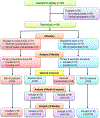Ultrasound-guided Percutaneous Cryoneurolysis to Treat Chronic Postamputation Phantom Limb Pain: A Multicenter Randomized Controlled Trial
- PMID: 36512721
- PMCID: PMC10374196
- DOI: 10.1097/ALN.0000000000004429
Ultrasound-guided Percutaneous Cryoneurolysis to Treat Chronic Postamputation Phantom Limb Pain: A Multicenter Randomized Controlled Trial
Abstract
Background: Postamputation phantom pain is notoriously persistent with few validated treatments. Cryoneurolysis involves the application of low temperatures to reversibly ablate peripheral nerves. The authors tested the hypothesis that a single cryoneurolysis treatment would decrease phantom pain 4 months later.
Methods: The authors enrolled patients with a lower-limb amputation and established phantom pain. Each received a single-injection femoral and sciatic nerve block with lidocaine and was subsequently randomized to receive either ultrasound-guided percutaneous cryoneurolysis or sham treatment at these same locations. The primary outcome was the change in average phantom pain intensity between baseline and 4 months as measured with a numeric rating scale (0 to 10), after which an optional crossover treatment was offered. Investigators, participants, and clinical staff were masked to treatment group assignment with the exception of the treating physician performing the cryoneurolysis, who had no subsequent participant interaction.
Results: Pretreatment phantom pain scores were similar in both groups, with a median [quartiles] of 5.0 [4.0, 6.0] for active treatment and 5.0 [4.0, 7.0] for sham. After 4 months, pain intensity decreased by 0.5 [-0.5, 3.0] in patients given cryoneurolysis (n = 71) versus 0 [0, 3] in patients given sham (n = 73), with an estimated difference (95% CI) of -0.1 (-1.0 to 0.7), P = 0.759. Following their statistical gatekeeping protocol, the authors did not make inferences or draw conclusions on secondary endpoints. One serious adverse event occurred after a protocol deviation in which a femoral nerve cryolesion was induced just below the inguinal ligament-instead of the sensory-only saphenous nerve-which resulted in quadriceps weakness, and possibly a fall and clavicle fracture.
Conclusions: Percutaneous cryoneurolysis did not decrease chronic lower extremity phantom limb pain 4 months after treatment. However, these results were based upon the authors' specific study protocol, and since the optimal cryoneurolysis treatment parameters such as freeze duration and anatomic treatment location remain unknown, further research is warranted.
Copyright © 2022, the American Society of Anesthesiologists. All Rights Reserved.
Conflict of interest statement
Conflicts of Interest (previous 3 years):
Figures





References
-
- Ziegler-Graham K, MacKenzie EJ, Ephraim PL, Travison TG, Brookmeyer R: Estimating the prevalence of limb loss in the United States: 2005 to 2050. Arch Phys Med Rehabil 2008; 89: 422–429 - PubMed
-
- Wartan SW, Hamann W, Wedley JR, McColl I: Phantom pain and sensation among British veteran amputees. Br J Anaesth 1997; 78: 652–659 - PubMed
-
- Flor H, Elbert T, Knecht S, Wienbruch C, Pantev C, Birbaumer N, Larbig W, Taub E: Phantom-limb pain as a perceptual correlate of cortical reorganization following arm amputation. Nature 1995; 375: 482–484 - PubMed

